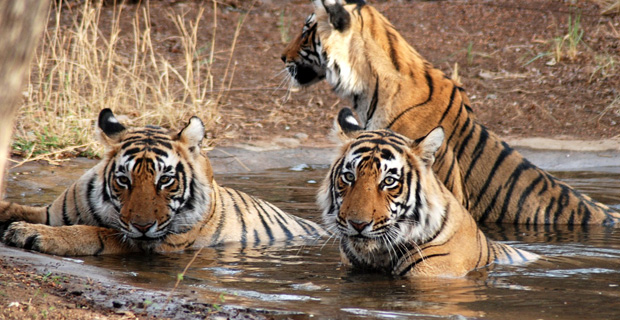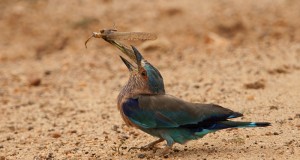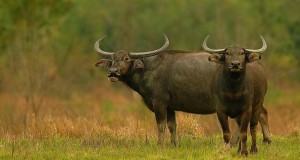The great virgin jungles of Central India were an awesome gift of nature which have been vandalized and largely destroyed over the years. What survives is but a small portion of its northwestern extremity.
This region, with its relics, is a historically i mportant reminder of the misty past. The fort of Ranthambore was the center of a Hindu Kingdom which was invested by Allaudin Khilji’s army in 1301 A.D. He later defeated its king, Raja Hamir, and the Rajput women are reputed to have committed the terrible ritual of sail in the fort. However, the area soon slipped back into the hands of the Rajputs and again became a powerful kingdom. The Mughal Emperor, Akbar, invested it in 1569, the year after he took the fort at Chittor, and conquered it in 40 days of warfare. The event was important enough to be commemorated with five magnificent miniature paintings by the emperor’s renowned artists, Miskina, Paras, K hem Karan, Mukund, Shankar and Lal, in the . imperial copy of Abul Fazl’s Akbar Hama, the official chronicle of Akbar’s reign. The Kachchwaha rulers of the principality of Amer (later known as the Jaipur state) received the fort from the Mughals and it remained with them till 1949 when Jaipur state was merged into Rajasthan. The forests around the fort, then known by the name of the nearby township of Sawai Mad hopur, were the private hunting grounds of the Maharajas of Jaipur. Among the most famous of their hunting parties was one organized for Queen Elizabeth 11 and the Duke of Edinburgh in 1961. It was thanks to the desire to preserve game for sport that the forest and its inhabitants first received protection and thus survived long enough to be rescued by Project Tiger.
In 1972, it was estimated that there were 1827 tigers in India, of which Rajasthan had 74 and the number of tigers estimated in the Ranthambore Sanctuary’s 60 sq miles (155 sq km) was 14. That year saw the launching of Project Tiger and this sanctuary, named after the fort, became one of the eight sanctuaries and national parks of the new project. Over the years, the sanctuary has become a national park with a core area of 158 sq miles (410 sq km) with a tiger population of 40 according to the 1986 census. In 1984, an additional area of 40 sq miles (104 sq km) of adjoining forest was designated the Sawai Man Singh Sanctuary, after the late Maharaja of Jaipur.
Friendly Tigers: Ranthambore is famous for its tigers and justly so. Over the last decade, as a result of strict preservation, tigers have become more and more active during the day, thus giving the lie to the earlier belief that they are nocturnal animals. More than in any other park or sanctuary in India, tigers are now encountered here in broad daylight. They have lost all fear of humans and are quite unperturbed by their presence. Besides hunting in broad daylight as well as at night, some other unique aspects of tiger behavior have been observed and photographed. Once, for instance, a magnificent large male hunted openly from the thickets on the edge of the lakes and ran down its sambar prey in the water. A tigress too indulged in similar behavior. There have been instances when a tiger and a crocodile from the lake have confronted each other. On one memorable occasion a tiger battled with a crocodile over a sambar carcass and finally took possession of it in broad daylight, after a long fight.
It was generally believed that tigers are solitary creatures and only the mothers take RanthainhoreNational Park241 care of their cubs so long as these are unable to care for themselves, and tigresses with cubs were seen only rarely. Here too their behavior seems to have undergone a change. In 1986, two tiger families, one with two cubs and another with three, have been extremely trusting of human presence in jeeps and have been observed for long stretches of time in jungle clearings in broad daylight, even when the cubs were but a few weeks old. The family with three cubs includes a large male which seems to have chosen to live with the cubs without being aggressive. In fact, this male is also seen with another tigress in the same Bakaula nala region from time to time.
Because of such tiger activities, Ranthambore is probably the best park in which to photograph them. In recent times it has become a center of attraction for wildlife photographers from all over the world. Sighting a tiger can never be a sure shot, but here one comes as close to it as is possible.
Other Predators: This park also has a large population of panthers which are the second largest predators of this forest. The prey species of tigers and panthers overlap, and because of possible conflicts between them, the latter are found more often on the periphery of the park. Kachida valley accounts for the highest number of sightings of these cats.They do not appear to be as fearlessly diurnal as tigers have become and therefore their sightings are not as frequent. Another interesting feature of the park is the visibility of marsh crocodiles in and around the lakes. Over the years, their number has increased and these reptiles, eight to 10 feet (2 1/2 three meters) in length, are not uncommon. They are easily seen in the water or basking on the shores of the lakes. Often they arc seen crossing from one lake to another. Interestingly, they eat dead sambar on land and try to drag the carcass into the water, even during daylight hours. Other predators in Ranthambore are hyenas, jackals and jungle cats. Caracal too have been recorded. The last sighting of wild dogs was way back in 1954; it is not known why they have disappeared from these forests completely.
Ranthambore has sloth bears which one may encounter while driving through the park. Lakarda and Anantpura are the areas where they are seen most often.
Sambar are seen everywhere and in large herds around the lakes. They are in hard horn and at their best during the rutting period in the winter months, though their antlers tend to be smaller than those of their counterparts in Central India. Sambar arc known to wallow in and like water, but here they can be observed in water for hours, eating and swimming in the lakes. Actually, one would expect such behavior from barasingha rather than sambar.
Chital are extremely common throughout the park and they come to water in their hundreds particularly in the warmer months. Nilgai too are found all over the park with the greatest concentration around the lakes; they roam in smaller herds than those of sambar and chital.
Sounders of wild boar can be seen around the lakes with an occasional chinkara (Indian gazelle) also coming along. Among others, Indian hare and mongoose are most visible on the edge of the water. Monitor lizards are common though shy; they are usually quick to notice vehicle movement and, by the time one notices them, they are scampering off to their burrows.
Though this park is famous for its animals, it is rich in hirdlife as well. Bonelli’s eagle, crested serpent eagle, great Indian horned owl, gray partridge, painted partridge, sandgrouse, quail, spur fowl, common pea fowl. tree pie, paradise flycatcher, pheasant-tailed jacana, painted stork, black stork, white-necked stork. spoonbill and green pigeon arc among the resident birds of the park. In addition, during the winter months, the park receives migrant visitors, primarily a variety of ducks.
These forests are around the Aravalli and the Vindhya ranges, each of which has distinctive geological features. The forest is of typically dry deciduous type with dhok being the most prominent tree. Ronj, ber, salai, occasional mango groves, palm trees, banyan and pipal trees give it a character all its own. Photographer’s Dream: The entry point to the National Park from Sawai Madhopur town takes the visitor to the foot of the Ranthambore fort and the forest rest house Jogi Mahal. India’s second-largest banyan tree rules supreme here with its visiting langur troupe. In front of the forest rest house is Padam Talao (tank) which takes its name from the water lilies in it. At the far end is the Raj Bagh Talao followed by Milak Talao which dries up in summer. These lakes attract considerable concentrations of ungulates which in turn attract tigers. On several occasions they have been seen from the edge of the lake and Jogi Mahal itself, hunting or resting in the water. Drives around these lakes are a wildlife photographer’s dream. From Jogi Mahal one can take pleasant drives to Nal Chan and Lahpur through the enchanting Dhok Avenue, to Bakaula and Anantpur via Lakarda, or to Kachida valley and Anantpura. These are the most frequented routes visitors take and both morning and evening outings are rewarding as animals are active at that time. A jeep is a must as the forest roads make it rather tough going at places.
Them park is studded with remnants of its historic past. Old defensive walls, wells, mosques and other structures bear mute testimony of kingdoms and battles long forgotten. Overgrown with pipal trees, they blend with their natural surroundings, thus lending to it an incomparable charm. Raj Bagh, a quadrangle with haradaris (sitting areas) between Padam Talao and Raj Bagh Talao, is a mixture of architectural styles with ruins of fountain systems and apartments. Tigers have often been seen roaming about freely in these ruins and some visitors have been lucky enough to be able to photograph them in these unlikely surroundings. The whole forest is dominated by the massive battlements of Ranthambore fort — worth visiting even for its own sake.





